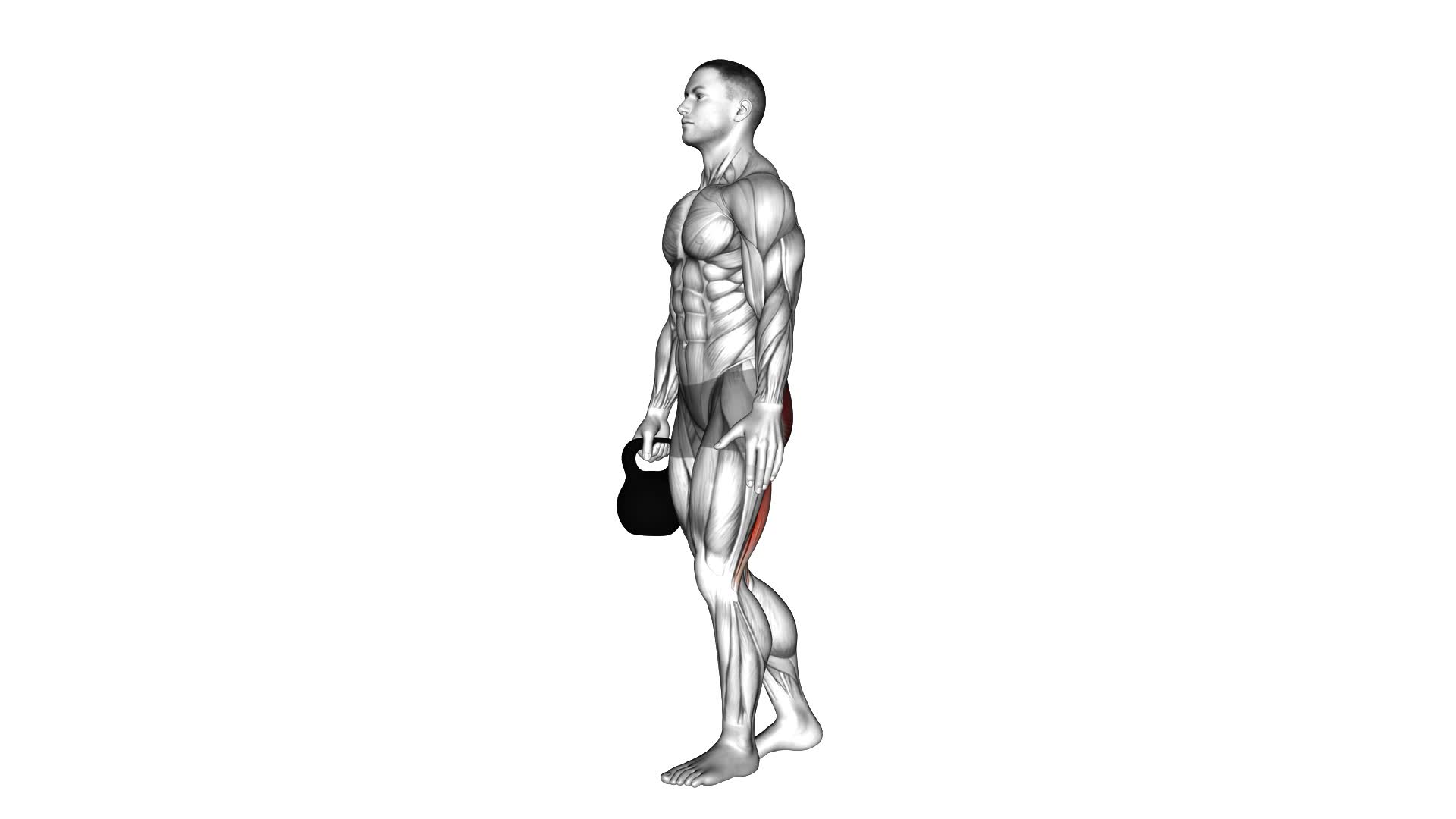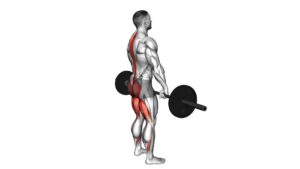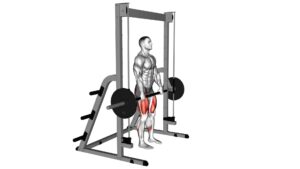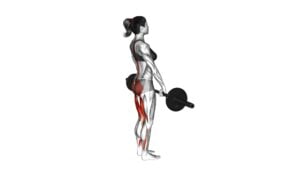Kettlebell One Legged Deadlift – Video Exercise Guide & Tips

Are you looking to strengthen your legs and improve your balance? Look no further than the kettlebell one-legged deadlift.
Watch This Exercise Video
In this exercise, you'll engage your core and target your glutes, hamstrings, and quads. With proper form and technique, you can reap the benefits of increased stability and muscle tone.
Whether you're a beginner or a seasoned fitness enthusiast, this exercise offers variations to suit your fitness level.
Get ready to maximize your results and take your workout to the next level.
Key Takeaways
- Proper form is essential in performing the kettlebell one-legged deadlift to improve balance, engage core muscles, and target specific muscle groups.
- Avoiding common mistakes such as rounding or arching the back, neglecting to engage the core, and poor balance and weight distribution reduces the risk of injury and ensures proper form throughout the exercise.
- Adjusting the exercise based on individual fitness levels, using lighter weights or no weight for beginners and increasing the weight or performing on an unstable surface for advanced individuals, allows for progression and challenges.
- Maintaining proper hip alignment, focusing on balance training, and engaging glutes while keeping a neutral spine are important for maximizing results and preventing injuries in the kettlebell one-legged deadlift.
Benefits of the Kettlebell One-Legged Deadlift
You can reap numerous benefits from incorporating the kettlebell one-legged deadlift into your workout routine. This exercise is highly effective for improving balance and strengthening your glutes.
The kettlebell one-legged deadlift requires you to stand on one leg while holding a kettlebell in one hand. As you lower the kettlebell towards the ground, you engage your glute muscles to maintain stability and control. This exercise helps to strengthen your glutes, which are essential for many everyday movements, as well as athletic performance.
Additionally, the kettlebell one-legged deadlift challenges your balance and proprioception, which is your body's awareness of its position in space. By performing this exercise regularly, you can improve your overall balance, stability, and coordination.
To perform the kettlebell one-legged deadlift with proper form and technique, it's important to keep your core engaged and your spine neutral. Maintain a soft bend in your standing leg and focus on hinging at your hips while keeping your back straight. As you lower the kettlebell, keep your shoulders square and your chest lifted.
Incorporating the kettlebell one-legged deadlift into your workout routine can provide significant benefits for improving balance and strengthening your glutes.
Now, let's move on to discussing the proper form and technique for this exercise.
Proper Form and Technique
To maintain proper form and technique during the kettlebell one-legged deadlift, focus on engaging your core and keeping your spine neutral. This exercise can be highly effective, but it's important to perform it correctly to avoid injury and maximize its benefits. Here are some key tips to help you maintain proper form and technique:
- Keep your core engaged: Engaging your core muscles throughout the movement will help stabilize your body and improve your balance. This will also prevent any excessive strain on your lower back.
- Maintain a neutral spine: It's crucial to keep your spine in a neutral position throughout the exercise. Avoid rounding or arching your back as this can put unnecessary stress on your spine. Imagine a straight line running from your head to your tailbone.
- Focus on your balance: One-legged exercises require good balance. Keep your supporting leg slightly bent and distribute your weight evenly through your foot. Engage your glutes and hamstrings as you lift the kettlebell, while keeping your chest lifted and shoulders back.
By following these tips, you can ensure that you're performing the kettlebell one-legged deadlift with proper form and technique, reducing the risk of injury and maximizing the benefits of this exercise.
COMMON MISTAKES:
- Rounding or arching the back
- Neglecting to engage the core
- Poor balance and weight distribution
SAMPLE WORKOUT:
- Perform 3 sets of 10 reps on each leg
- Use a kettlebell that challenges you, but allows you to maintain proper form
- Rest for 30 seconds between sets
Variations for Different Fitness Levels
Maintain proper form and technique during the kettlebell one-legged deadlift by incorporating variations suited for different fitness levels. Whether you're a beginner or an advanced exerciser, there are progression options and modifications available to help you get the most out of this exercise.
For beginners, it's important to start with lighter weights and focus on mastering the basic movement pattern. You can begin by performing the one-legged deadlift without any weight, focusing on balance and stability. As you become more comfortable, you can gradually add weight by using a smaller kettlebell or dumbbell.
Another modification for beginners is to perform the exercise with a support. This can be done by holding onto a wall, railing, or using a chair for stability. By having something to hold onto, you can focus on maintaining proper form and gradually build strength and stability.
For those who are more advanced and looking for a challenge, there are several progression options available. One option is to increase the weight of the kettlebell, challenging your muscles even more. You can also try performing the exercise on an unstable surface, such as a balance board or Bosu ball, to further engage your core and improve balance.
Common Mistakes to Avoid
To ensure proper form during the kettlebell one-legged deadlift, it's important to focus on three key points.
First, make sure your hips are aligned correctly in order to avoid any strain or injury.
Second, engage your core muscles throughout the exercise to provide stability and support.
Lastly, be mindful of maintaining a straight back and avoiding rounding your shoulders.
Proper Hip Alignment
Ensure proper alignment of your hips during the kettlebell one-legged deadlift to avoid common mistakes. Proper hip alignment is crucial for maximizing the effectiveness of this exercise and minimizing the risk of injury. Here are three important factors to consider:
- Hip flexibility: Before attempting the kettlebell one-legged deadlift, it's essential to have adequate hip flexibility. Tight hips can lead to improper alignment and strain on the lower back. Incorporate regular hip stretches into your routine to improve flexibility and enhance your performance.
- Balance training: Maintaining proper balance is key to executing the kettlebell one-legged deadlift correctly. Engaging your core muscles and focusing on your center of gravity will help you stay stable throughout the movement. Incorporate balance training exercises, such as single-leg stance or yoga poses, to improve your overall stability.
- Alignment cues: Pay attention to the alignment of your hips during the exercise. Keep your standing leg slightly bent and your hips level. Avoid leaning to one side or allowing your hip to drop. Engaging your glutes and keeping a neutral spine will help you maintain the proper hip alignment.
Engaging Core Muscles
Focus on engaging your core muscles to avoid common mistakes while performing the kettlebell one-legged deadlift. Engaging your core muscles is crucial for maintaining stability and balance throughout the exercise.
Your core muscles, including your abdominals, obliques, and lower back, play a vital role in stabilizing your spine and pelvis. By activating these muscles, you can protect your lower back from injury and maintain proper form.
Additionally, engaging your glute muscles is essential for generating power and stability during the movement. Your glutes help to drive your hips forward and maintain balance throughout the exercise.
To engage your core and glute muscles, focus on keeping your spine neutral, engaging your abdominals, and squeezing your glutes at the top of the movement.
Avoiding Rounded Back
Maintaining a neutral spine is crucial to avoid a rounded back while performing the kettlebell one-legged deadlift. When your back is rounded, it puts excessive stress on your spine and increases the risk of injury.
Here are three common mistakes to avoid when trying to maintain a neutral spine:
- Avoid hunching your shoulders forward: Keep your shoulders pulled back and down throughout the movement. This helps to maintain proper alignment and prevent rounding of the upper back.
- Engage your core muscles: A strong core is essential for stabilizing your spine and maintaining proper posture. Focus on engaging your abdominal muscles by drawing your belly button in towards your spine.
- Keep your hips level: As you hinge forward, be mindful of keeping your hips level. This helps to engage your glutes and improve balance.
By avoiding these common mistakes and maintaining a neutral spine, you can maximize the benefits of the kettlebell one-legged deadlift.
Now let's move on to some tips for maximizing results.
Tips for Maximizing Results
To maximize your results with the kettlebell one-legged deadlift, it's crucial to focus on proper form. Maintaining a stable core, keeping your back straight, and engaging your glutes and hamstrings will ensure that you're targeting the correct muscles and preventing injury.
Additionally, consistency is key. By incorporating this exercise into your routine regularly, you'll see gradual progress and improvements in strength and balance.
Proper Form Importance
To maximize your results during the kettlebell one-legged deadlift exercise, it's crucial that you prioritize proper form. Proper form not only helps you achieve the desired outcomes but also prevents injuries. Here are three reasons why maintaining proper form is important:
- Importance of Balance: Proper form ensures that you maintain a stable and balanced position throughout the exercise. This helps activate the muscles correctly and prevents any unnecessary strain on your body.
- Avoiding Injury: By maintaining proper form, you reduce the risk of injury. It helps you engage the correct muscles, distribute the weight evenly, and protect your joints from unnecessary stress.
- Maximizing Results: Proper form allows you to target the right muscles effectively, leading to better overall results. It ensures that you're engaging the intended muscles and making the most out of each repetition.
Consistency Yields Progress
By consistently practicing proper form, you can further enhance your performance and maximize the results of the kettlebell one-legged deadlift exercise. Consistency is key when it comes to reaping the benefits of this exercise. When you perform the kettlebell one-legged deadlift regularly, you train your muscles to adapt and become stronger over time.
This exercise targets your glutes, hamstrings, and lower back, helping to improve your overall strength and stability. Additionally, consistency allows you to track your progress more effectively. By keeping a record of the weight you use, the number of repetitions, and any modifications you make, you can see how far you've come and set new goals for yourself.
Now, let's dive into a sample workout routine that incorporates the kettlebell one-legged deadlift.
Sample Workout Routine
Create an effective sample workout routine using a double preposition for performing the Kettlebell One Legged Deadlift exercise. Incorporating this exercise into your routine can help improve your balance and stability. Here's a sample workout routine for you to try:
- Warm-up:
Begin with a 5-minute dynamic warm-up to prepare your body for the workout. Include exercises like leg swings, hip circles, and ankle rotations to mobilize your joints.
- Kettlebell One Legged Deadlift:
Start with 3 sets of 8-10 reps on each leg. Hold a kettlebell in one hand and stand on one leg with a slight bend in your knee. Hinge forward at your hips while keeping your back straight and lift your free leg behind you. Lower the kettlebell towards the ground and then return to the starting position. Switch legs and repeat.
- Superset:
Finish your workout with a superset of exercises that target your lower body and core. Perform 3 sets of 12-15 reps of Bulgarian split squats on each leg, followed by 3 sets of 12-15 reps of Russian twists with a medicine ball.
Remember to start with a weight that challenges you but allows you to maintain proper form. As you become more comfortable with the exercise, gradually increase the weight and intensity. Always listen to your body and modify the routine as needed.
Frequently Asked Questions
What Is the Recommended Weight for Beginners to Start With When Performing the Kettlebell One-Legged Deadlift?
When starting the kettlebell one-legged deadlift as a beginner, it's important to choose the right weight. The recommended weight for beginners may vary depending on your fitness level and strength. It's best to start with a lighter kettlebell to ensure proper form and prevent injuries.
As you become more comfortable and confident, you can gradually increase the weight. Remember to always modify the exercise if you have any injuries to avoid further strain.
Can the Kettlebell One-Legged Deadlift Help Improve Balance and Stability?
The kettlebell one-legged deadlift is an exercise that can help improve your balance and stability. By focusing on one leg at a time, you challenge your body to engage the smaller stabilizing muscles in your legs and core.
This exercise targets the glutes, hamstrings, and lower back while also strengthening your core. By incorporating the kettlebell, you add resistance and increase the intensity of the exercise, making it even more effective for improving balance and stability.
How Often Should the Kettlebell One-Legged Deadlift Be Performed in a Workout Routine?
To get the most out of the Kettlebell One Legged Deadlift, it's important to know how often to perform it in your workout routine.
This exercise can be done two to three times a week to see great benefits.
It helps improve balance and stability while targeting your glutes, hamstrings, and core.
If you have any injuries or limitations, you can modify the exercise by using a lighter kettlebell or doing it without any weight.
Is It Necessary to Use a Kettlebell for the One-Legged Deadlift, or Can Other Weights Be Used as Well?
Yes, it's possible to use other weights for the one-legged deadlift besides a kettlebell. However, it's recommended to use a kettlebell because it offers unique benefits.
The kettlebell's shape and handle allow for a better grip and balance during the exercise. Additionally, the uneven distribution of weight in a kettlebell challenges your core muscles and stability more effectively.
Can the Kettlebell One-Legged Deadlift Be Modified for Individuals With Knee or Hip Injuries?
The kettlebell one-legged deadlift can indeed be modified for individuals with knee or hip injuries. By using lighter weights or even just bodyweight, you can still benefit from this exercise without putting unnecessary strain on your joints.
Additionally, focusing on proper form and technique is crucial to prevent further injury. The kettlebell one-legged deadlift is great for improving balance and stability, even with modifications.
Conclusion
In conclusion, the kettlebell one-legged deadlift is a highly effective exercise for improving strength, balance, and stability. By maintaining proper form and technique, individuals can target their glutes, hamstrings, and core muscles.
The exercise can be modified to suit different fitness levels, and it's important to avoid common mistakes to prevent injuries. By following these tips and incorporating the exercise into a regular workout routine, individuals can maximize their results and achieve their fitness goals.

Author
Years ago, the spark of my life’s passion ignited in my mind the moment I stepped into the local gym for the first time. The inaugural bead of perspiration, the initial endeavor, the very first surge of endorphins, and a sense of pride that washed over me post-workout marked the beginning of my deep-seated interest in strength sports, fitness, and sports nutrition. This very curiosity blossomed rapidly into a profound fascination, propelling me to earn a Master’s degree in Physical Education from the Academy of Physical Education in Krakow, followed by a Sports Manager diploma from the Jagiellonian University. My journey of growth led me to gain more specialized qualifications, such as being a certified personal trainer with a focus on sports dietetics, a lifeguard, and an instructor for wellness and corrective gymnastics. Theoretical knowledge paired seamlessly with practical experience, reinforcing my belief that the transformation of individuals under my guidance was also a reflection of my personal growth. This belief holds true even today. Each day, I strive to push the boundaries and explore new realms. These realms gently elevate me to greater heights. The unique combination of passion for my field and the continuous quest for growth fuels my drive to break new ground.







